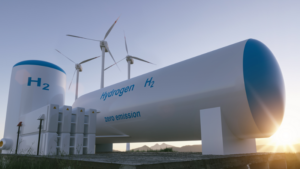
On the edge of the Saudi Arabian desert beside the Red Sea, a futuristic city called Neom is due to be built. The $500bn (£380bn) city – complete with flying taxis and robotic domestic help – is planned to become home to a million people. And what energy product will be used both to power this city and sell to the world? Not oil. Instead, Saudi Arabia is banking on a different fuel – green hydrogen. This carbon-free fuel made is from water by using renewably produced electricity to split hydrogen molecules from oxygen molecules.
This summer, a large US gas company, Air Products & Chemicals, announced that as part of Neom it has been building a green hydrogen plant in Saudi Arabia for the past four years. The plant is powered by 4 GW of electricity from wind and solar projects that sprawl across the desert. It claims to be the world’s largest green hydrogen project – and more Saudi plants are on the drawing board.
The Saudis aren’t alone in seeing green hydrogen as the next big thing in energy. While the fuel is barely on the radar in the United States, around the world a green hydrogen rush is underway, and many companies, investors, governments and environmentalists believe it is an energy source that could help end the reign of fossil fuels and slow the world’s warming trajectory.